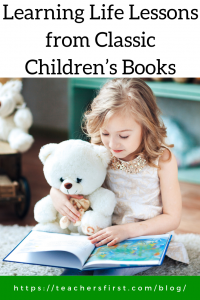All that I hope to say in books, all that I ever hope to say, is that I love the world.
E. B. White
 Do you have a favorite children’s book? Perhaps you still remember your favorite book from childhood. My favorite was the Little House on the Prairie series. When this book collection became a television show, I learned (without even knowing it) how to compare and contrast the written words in a book with the screen version.
Do you have a favorite children’s book? Perhaps you still remember your favorite book from childhood. My favorite was the Little House on the Prairie series. When this book collection became a television show, I learned (without even knowing it) how to compare and contrast the written words in a book with the screen version.
It is easy to think that books written many years ago don’t have relevance with today’s world; however, I would argue that there are many reasons to ensure that classic books are part of the learning process of every child. One of the most important reasons is that they teach life lessons through the art of storytelling. This article from Southern Living provides some excellent examples of lessons learned from children’s books.
In honor of the July 11, 1899 birthdate of E. B. White, let’s think about just a few of the life lessons found in Charlotte’s Web:
- Appreciate diversity – think about the variety of animals in this book who live together. They start separately from each other within the shared space of the barn but learn to work together as a team.
- Show compassion – through both big and small acts, both Wilbur and Charlotte demonstrate compassion in a variety of ways.
- The value of friendship – learning about the importance of friendship is the basis of this novel. Understanding and appreciating friendship gave purpose to the lives of Wilbur and Charlotte.
Although the classics are “old’ books, fortunately, we enjoy many different ways to learn about them through technology. These books stand on their own and don’t need to be brought up to date; however; using technology expands our opportunities for students to explore and learn beyond the covers of the book.
Here are some excellent resources for finding and sharing information about classic children’s books and using them as inspiration for your young writers:
- Reading Rockets Author Video Interviews (TeachersFirst review) – learn about more than 130 favorite children’s authors through video conversations. Check out the link to the Author Study Toolkit to find ten ideas on implementing author study units. After watching some of the videos, have students interview peers as authors and share the videos on your class website. Prepare for interviews using the Bio Cube (TeachersFirst review) shared at ReadWriteThink (TeachersFirst review). Don’t forget to include a discussion of the life lesson shared in your young author’s work!
- Just One More Book Podcast (TeachersFirst review) – this podcast is all about children’s books. Search through the site to listen to reviews of books written by your favorite authors, or find new books by browsing through the over 400 podcasts on the website. After listening to these podcasts you and your students will want to make your own. Give it a try with Anchor (TeachersFirst review). Use Anchor’s features for students to create and share their podcast easily. Nothing is more rewarding than students knowing that others hear and appreciate their message. Consider setting up a podcast schedule sharing a life lesson from a book, discuss common themes found in children’s books, or short book reviews on a bi-weekly or monthly basis to share with others in your school community.
- Book Creator (TeachersFirst review)– take your books from paper to interactive digital content with Book Creator. Have students share their thoughts on life lessons learned in a classic novel, complete an author study, or write original content using Book Creator. This interactive tool lets students add drawings, text, videos, and more to create a one-of-a-kind book. Proudly publish and share their creations for family and friends to view anytime and from anywhere.
Reading and discussing classic books is not only enjoyable, it also provides many opportunities for sharing common interests and learning about life through the experiences of the characters in a book.
What children’s classic book do you relate to your childhood? How do you share it with your students? We love to hear your thoughts and teaching ideas; be sure to share them in the comments below.

